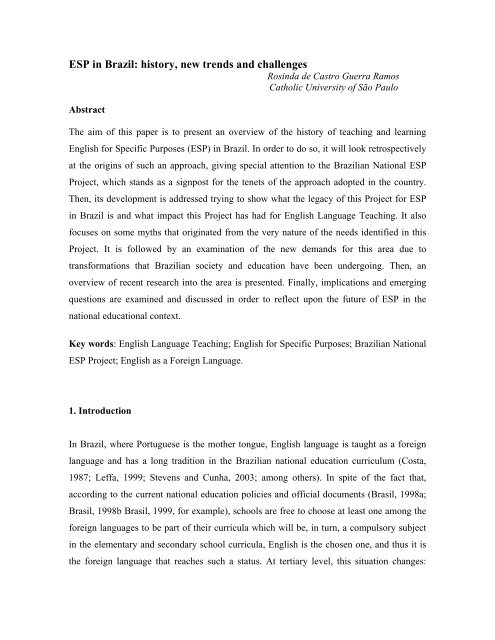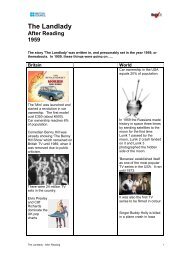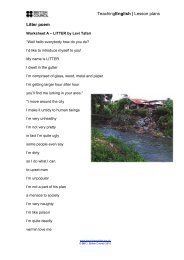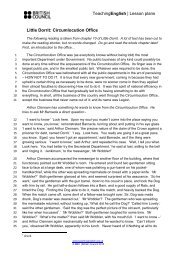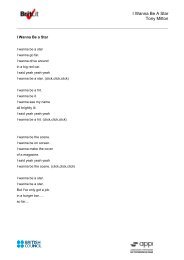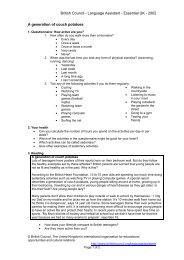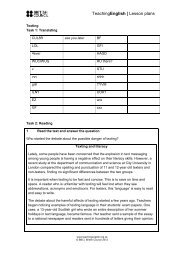ESP in Brazil:origins, development and new trends - TeachingEnglish
ESP in Brazil:origins, development and new trends - TeachingEnglish
ESP in Brazil:origins, development and new trends - TeachingEnglish
You also want an ePaper? Increase the reach of your titles
YUMPU automatically turns print PDFs into web optimized ePapers that Google loves.
<strong>ESP</strong> <strong>in</strong> <strong>Brazil</strong>: history, <strong>new</strong> <strong>trends</strong> <strong>and</strong> challenges<br />
Ros<strong>in</strong>da de Castro Guerra Ramos<br />
Catholic University of São Paulo<br />
Abstract<br />
The aim of this paper is to present an overview of the history of teach<strong>in</strong>g <strong>and</strong> learn<strong>in</strong>g<br />
English for Specific Purposes (<strong>ESP</strong>) <strong>in</strong> <strong>Brazil</strong>. In order to do so, it will look retrospectively<br />
at the orig<strong>in</strong>s of such an approach, giv<strong>in</strong>g special attention to the <strong>Brazil</strong>ian National <strong>ESP</strong><br />
Project, which st<strong>and</strong>s as a signpost for the tenets of the approach adopted <strong>in</strong> the country.<br />
Then, its <strong>development</strong> is addressed try<strong>in</strong>g to show what the legacy of this Project for <strong>ESP</strong><br />
<strong>in</strong> <strong>Brazil</strong> is <strong>and</strong> what impact this Project has had for English Language Teach<strong>in</strong>g. It also<br />
focuses on some myths that orig<strong>in</strong>ated from the very nature of the needs identified <strong>in</strong> this<br />
Project. It is followed by an exam<strong>in</strong>ation of the <strong>new</strong> dem<strong>and</strong>s for this area due to<br />
transformations that <strong>Brazil</strong>ian society <strong>and</strong> education have been undergo<strong>in</strong>g. Then, an<br />
overview of recent research <strong>in</strong>to the area is presented. F<strong>in</strong>ally, implications <strong>and</strong> emerg<strong>in</strong>g<br />
questions are exam<strong>in</strong>ed <strong>and</strong> discussed <strong>in</strong> order to reflect upon the future of <strong>ESP</strong> <strong>in</strong> the<br />
national educational context.<br />
Key words: English Language Teach<strong>in</strong>g; English for Specific Purposes; <strong>Brazil</strong>ian National<br />
<strong>ESP</strong> Project; English as a Foreign Language.<br />
1. Introduction<br />
In <strong>Brazil</strong>, where Portuguese is the mother tongue, English language is taught as a foreign<br />
language <strong>and</strong> has a long tradition <strong>in</strong> the <strong>Brazil</strong>ian national education curriculum (Costa,<br />
1987; Leffa, 1999; Stevens <strong>and</strong> Cunha, 2003; among others). In spite of the fact that,<br />
accord<strong>in</strong>g to the current national education policies <strong>and</strong> official documents (Brasil, 1998a;<br />
Brasil, 1998b Brasil, 1999, for example), schools are free to choose at least one among the<br />
foreign languages to be part of their curricula which will be, <strong>in</strong> turn, a compulsory subject<br />
<strong>in</strong> the elementary <strong>and</strong> secondary school curricula, English is the chosen one, <strong>and</strong> thus it is<br />
the foreign language that reaches such a status. At tertiary level, this situation changes:
English may be a compulsory or optional subject, depend<strong>in</strong>g on the field of specialism (e.g.<br />
hotel <strong>in</strong>dustry, tourism, comput<strong>in</strong>g; generally these specialism have it as a compulsory<br />
subject) <strong>and</strong>/or on the <strong>in</strong>stitution, i.e., faculties <strong>and</strong> universities <strong>in</strong> the country may or may<br />
not choose to have a foreign language <strong>in</strong> their curricula.<br />
Def<strong>in</strong>itely, as <strong>in</strong> many other countries <strong>in</strong> the globalized world, ELT plays an important role<br />
<strong>in</strong> the national education context. On the other h<strong>and</strong>, one may wonder what role English for<br />
Specific Purposes (<strong>ESP</strong>) plays <strong>in</strong> <strong>Brazil</strong>? The answer is: <strong>ESP</strong> has also its place <strong>in</strong> the<br />
<strong>Brazil</strong>ian educational context. It is now a well-established area <strong>in</strong> the field of language<br />
teach<strong>in</strong>g <strong>and</strong> learn<strong>in</strong>g <strong>in</strong> the country. As already attested elsewhere (Ramos, 2005), <strong>ESP</strong> is<br />
part of the title of <strong>in</strong>numerable <strong>new</strong> textbooks that were put on the market <strong>in</strong> the last 10<br />
years. It is part of the content <strong>in</strong>dicated for the tertiary level entrance exams (named<br />
Vestibular) <strong>in</strong> the country. It is the name of many courses that are offered <strong>in</strong> <strong>Brazil</strong>ian<br />
universities.The question is when <strong>and</strong> how has <strong>ESP</strong> started appear<strong>in</strong>g <strong>in</strong> the <strong>Brazil</strong>ian<br />
foreign language teach<strong>in</strong>g-learn<strong>in</strong>g scenario?<br />
Part of this paper is devoted to provid<strong>in</strong>g an answer to this question. This approach<br />
appeared <strong>in</strong> <strong>Brazil</strong> <strong>in</strong> the late 1970s <strong>and</strong> brought <strong>new</strong> knowledge <strong>and</strong> changes to the<br />
classroom practice <strong>and</strong> <strong>in</strong>stitutional educational sectors, as for an example, the national<br />
entrance exams (Vestibular) <strong>in</strong> the country. The aim of this paper is to focus on the history<br />
of the teach<strong>in</strong>g <strong>and</strong> learn<strong>in</strong>g of <strong>ESP</strong> <strong>in</strong> <strong>Brazil</strong>, tackl<strong>in</strong>g issues retrospectively. It beg<strong>in</strong>s with<br />
the orig<strong>in</strong>s of this approach <strong>in</strong> the country <strong>in</strong> the 1970s, giv<strong>in</strong>g special attention to the<br />
National <strong>ESP</strong> Project, a signpost for the tenets of the approach adopted <strong>in</strong> the country, as<br />
well as its <strong>development</strong> try<strong>in</strong>g to reflect on the characteristics of this Project <strong>and</strong> its legacy<br />
to the area. It is followed by an exam<strong>in</strong>ation of some myths that were constructed dur<strong>in</strong>g<br />
the implementation of the <strong>ESP</strong> <strong>Brazil</strong>ian National Project, myths which orig<strong>in</strong>ated from the<br />
very nature of the needs of the <strong>Brazil</strong>ian context. F<strong>in</strong>ally, it presents a current overview of<br />
the <strong>ESP</strong> teach<strong>in</strong>g <strong>and</strong> learn<strong>in</strong>g context <strong>and</strong> research, po<strong>in</strong>ts to <strong>new</strong> ways of <strong>in</strong>vestigation<br />
<strong>and</strong> the challenges that such ways generate; moves to consideration of implications of these<br />
<strong>in</strong>vestigations <strong>and</strong> the challenges that these changes have brought about, <strong>and</strong> attempts to<br />
<strong>in</strong>dicate how the future may be constructed.
2. The History of <strong>ESP</strong> <strong>in</strong> <strong>Brazil</strong>: orig<strong>in</strong>s <strong>and</strong> <strong>development</strong><br />
It is impossible to present the history of <strong>ESP</strong> <strong>in</strong> <strong>Brazil</strong> without <strong>in</strong>troduc<strong>in</strong>g the history of the<br />
<strong>Brazil</strong>ian National <strong>ESP</strong> Project. They are <strong>in</strong>extricably l<strong>in</strong>ked. Therefore, <strong>in</strong> order to offer a<br />
coherent <strong>and</strong> fair portrayal of this Project, Celani et al. (1988), Celani (2005) <strong>and</strong> the<br />
author’s own experience will be the sources used to describe its genesis, organization <strong>and</strong><br />
<strong>development</strong>.<br />
2.1. The <strong>Brazil</strong>ian National <strong>ESP</strong> Project<br />
<strong>ESP</strong> <strong>in</strong> <strong>Brazil</strong> appeared <strong>in</strong> the late 1970s as a reaction to a need. As <strong>in</strong>dicated <strong>in</strong> Celani et al<br />
(1988) <strong>and</strong> Celani (2005) many factors contributed to the need of creat<strong>in</strong>g a center of<br />
excellence <strong>in</strong> <strong>ESP</strong> equipped to offer advice, resources <strong>and</strong> teacher education for <strong>Brazil</strong>ian<br />
universities. The first of these, accord<strong>in</strong>g to the authors, was the large number of university<br />
teachers from various parts of the country who were then do<strong>in</strong>g their M.A. <strong>in</strong> Applied<br />
L<strong>in</strong>guistics at the Pontifical Catholic University of São Paulo (PUC-SP) <strong>and</strong> who showed<br />
strong <strong>in</strong>terest <strong>in</strong> <strong>ESP</strong> due to the fact that they did not feel confident or even well-prepared<br />
to offer specialised English courses for the various departments of their universities. It is<br />
<strong>in</strong>terest<strong>in</strong>g to po<strong>in</strong>t out that at the time most of the English departments devoted their<br />
expertise to provid<strong>in</strong>g courses as part of a degree <strong>in</strong> languages <strong>and</strong> a transition to offer<br />
specialised courses <strong>in</strong> <strong>ESP</strong> seemed an <strong>in</strong>surmountable obstacle. A second factor was the<br />
way the teach<strong>in</strong>g of <strong>ESP</strong> was regarded by most of the English teachers: “a less noble<br />
activity than teach<strong>in</strong>g English language <strong>and</strong> literature <strong>in</strong> an English degree course” (Celani,<br />
2005:14). Furthermore, the dem<strong>and</strong>s from the pure <strong>and</strong> applied sciences departments at the<br />
universities for specialised English courses started putt<strong>in</strong>g pressure on the English<br />
departments so that it became impossible to disregard the problem. These factors together<br />
with the number of requests for advice on the design <strong>and</strong> implementation of <strong>ESP</strong> courses<br />
from universities throughout the national territory made Professor Maria Antonieta Alba
Celani (then the coord<strong>in</strong>ator of the Applied L<strong>in</strong>guistics Programme at the Catholic<br />
University of São Paulo) design a project at national level. In order to do so, a bid was put<br />
<strong>in</strong> to the <strong>Brazil</strong>ian M<strong>in</strong>istry of Education for f<strong>in</strong>ancial support <strong>in</strong> 1977.<br />
From 1977 to 1979 efforts were made to establish the Project. Funds were granted <strong>and</strong><br />
Professor Celani count<strong>in</strong>g on the expertise <strong>in</strong> the teach<strong>in</strong>g of <strong>ESP</strong> of a British Council<br />
visit<strong>in</strong>g professor, Maurice Broughton, set up an <strong>in</strong>itial programme of visits to twenty<br />
federal universities that, accord<strong>in</strong>g to Celani et al. (1988), were the ones that promptly<br />
accepted the <strong>in</strong>vitation to participate. These authors also po<strong>in</strong>ted out that the needs analysis<br />
to be carried out should count on personal contact, essential <strong>in</strong> a country the size of <strong>Brazil</strong><br />
<strong>and</strong> with so many regional differences. The aims of these visits were to meet as many<br />
people at different levels <strong>in</strong> the university as possible to get <strong>in</strong>formation about the<br />
necessities of hav<strong>in</strong>g a national project, the resources <strong>and</strong> facilities available, teach<strong>in</strong>g staff,<br />
students numbers, class size, attitudes to <strong>ESP</strong> <strong>and</strong> discipl<strong>in</strong>es catered to, <strong>in</strong> each university.<br />
The results of this needs analysis showed the necessity for a national project <strong>and</strong> made<br />
apparent the paths to be followed: teacher <strong>development</strong>; materials production; the teach<strong>in</strong>g<br />
of read<strong>in</strong>g skills as of paramount importance for students <strong>and</strong> researchers who had to read<br />
academic literature; the sett<strong>in</strong>g up of a national resource centre.<br />
As there was sufficient <strong>in</strong>terest <strong>in</strong> hav<strong>in</strong>g a national project, Professor Celani put <strong>in</strong> a bid to<br />
the British Council, for three Key English Language Teach<strong>in</strong>g (KELTs) posts to be set up,<br />
two at the Catholic University of São Paulo <strong>and</strong> one at the Federal University of Santa<br />
Catar<strong>in</strong>a (a state <strong>in</strong> the south part of <strong>Brazil</strong>), who would be responsible for teacher<br />
<strong>development</strong>, research <strong>and</strong> materials production. The arrival of the three specialists (John<br />
Holmes, Mike Scott <strong>and</strong> Tony Deyes) near the end of 1980 marked the <strong>development</strong> phase<br />
of the Project, with three more universities jo<strong>in</strong><strong>in</strong>g <strong>in</strong>, <strong>and</strong> went on with official support<br />
until the end of 1989.<br />
The <strong>development</strong> phase started with a national sem<strong>in</strong>ar aim<strong>in</strong>g at discuss<strong>in</strong>g policy <strong>and</strong><br />
work to be done. As reported by Celani et al. (1988), this meet<strong>in</strong>g brought together the<br />
national coord<strong>in</strong>at<strong>in</strong>g team <strong>and</strong> the coord<strong>in</strong>ators of the local team <strong>in</strong> each university, who
were chosen by their peers. At this po<strong>in</strong>t, it is important to br<strong>in</strong>g one of the pr<strong>in</strong>ciples of the<br />
Project, i.e. the national coord<strong>in</strong>at<strong>in</strong>g team would not <strong>in</strong>terfere with the way <strong>in</strong> which local<br />
teams would choose to organise themselves. Dur<strong>in</strong>g this event it was decided that the<br />
teacher <strong>development</strong> programme would be set up <strong>in</strong> the form of sem<strong>in</strong>ars <strong>and</strong> local visits<br />
supplemented by scholarships (provided by the fund<strong>in</strong>g agencies) to UK universities<br />
whenever possible.<br />
The year 1981 was dedicated to hold<strong>in</strong>g sem<strong>in</strong>ars <strong>in</strong> most of the participat<strong>in</strong>g universities.<br />
The KELTs´ visits, as Celani et al. (1988) mention, besides contribut<strong>in</strong>g to the <strong>development</strong><br />
of the local teams, provided the specialists with the opportunity to be acqua<strong>in</strong>ted with the<br />
needs of each specific local team. In subsequent years, visits went on with decreas<strong>in</strong>g<br />
<strong>in</strong>tensity. A further result of these <strong>in</strong>itial visits was the contribution of topics (e.g. read<strong>in</strong>g<br />
strategies, a m<strong>in</strong>imum discourse grammar, text analysis, course design, self-access,<br />
discourse <strong>and</strong> scientific discourse, the use of cognates, the role of materials, the teacher as a<br />
researcher etc) for one of the publications of the Project, a series of Work<strong>in</strong>g Papers<br />
(totall<strong>in</strong>g 21 numbers) that serve not only as a list of contents to be dealt with dur<strong>in</strong>g the<br />
visits, but chiefly as a set of core ideas to set down some beliefs <strong>and</strong> guidance which could<br />
be followed up by much more <strong>in</strong>-depth <strong>and</strong> detailed work <strong>in</strong> workshops, <strong>and</strong> at the same<br />
time which <strong>in</strong>terested parties could be later followed up over the years.<br />
From 1981 to 1989 an annual sem<strong>in</strong>ar <strong>and</strong> three regional sem<strong>in</strong>ars (the country was divided<br />
<strong>in</strong> three regions) were held <strong>in</strong> different cities <strong>and</strong> states of the country. The aim of these<br />
sem<strong>in</strong>ars was the exchange of ideas <strong>and</strong> experiences among the participat<strong>in</strong>g teams, as well<br />
as the “<strong>development</strong> of a set of pr<strong>in</strong>ciples which might come to be shared by most of the<br />
teachers <strong>in</strong>volved <strong>in</strong>” (Celani et al., 1988:6), as the Project coord<strong>in</strong>ation had taken the<br />
decision of not impos<strong>in</strong>g pr<strong>in</strong>ciples from a central authority to be obeyed. Another<br />
important implication result<strong>in</strong>g from these sem<strong>in</strong>ars to be mentioned is that as they were<br />
open to the regional community year after year a larger number of teachers not officially<br />
connected with the Project started tak<strong>in</strong>g part <strong>in</strong> these meet<strong>in</strong>gs on regular basis. This made<br />
it possible for more teachers to become acqua<strong>in</strong>ted with the approach, contribut<strong>in</strong>g hence to<br />
the dissem<strong>in</strong>ation of <strong>ESP</strong> <strong>in</strong> the country.
Another important decision taken by the Project members, accord<strong>in</strong>g to Celani et al. (1988),<br />
was that of not hav<strong>in</strong>g a “Project textbook”. This decision was derived from several factors:<br />
differences <strong>in</strong> the levels of teacher <strong>development</strong>; the variety of different academic<br />
discipl<strong>in</strong>es to be catered for, <strong>and</strong> the different levels (first year undergraduate through to<br />
postgraduates). As Celani et al. (1988:6) states:<br />
“The major factor, however, was the belief that teacher <strong>in</strong>volvement<br />
is essential <strong>in</strong> the production <strong>and</strong> cont<strong>in</strong>ued use of <strong>ESP</strong> materials <strong>in</strong><br />
the classroom. It would not be coherent with the Project philosophy<br />
(…), to produce materials <strong>and</strong> then tra<strong>in</strong> teachers to use them.<br />
Instead, teachers should be helped to produce their own materials,<br />
however uneven the products thus created might be, <strong>and</strong> however<br />
much “re-<strong>in</strong>vent<strong>in</strong>g the wheel” might go on. This is consistent with<br />
a process as opposed to product orientation.”<br />
In spite of this philosophy, however, sample materials were produced: Resource Packages<br />
(totall<strong>in</strong>g 5) to illustrate not only the set core of ideas that the Project was adopt<strong>in</strong>g<br />
consider<strong>in</strong>g the teach<strong>in</strong>g <strong>and</strong> learn<strong>in</strong>g of read<strong>in</strong>g, but also how teachers could deal with the<br />
follow<strong>in</strong>g topics: the exploration of authentic texts with beg<strong>in</strong>ners; the use of read<strong>in</strong>g<br />
strategies; the teach<strong>in</strong>g of grammar; vocabulary acquisition <strong>and</strong> read<strong>in</strong>g strategies; <strong>and</strong><br />
test<strong>in</strong>g read<strong>in</strong>g comprehension. Also self-access materials <strong>and</strong> a read<strong>in</strong>g “st<strong>and</strong>ard<br />
exercise” were developed on experimental basis at the University of Santa Catar<strong>in</strong>a (Scott,<br />
1984) <strong>and</strong> then used by the participat<strong>in</strong>g universities. I myself <strong>in</strong> the mid 1980s used the<br />
“st<strong>and</strong>ard exercise” both as an activity <strong>in</strong> the classroom (but modified later), <strong>and</strong> as the<br />
basis for design<strong>in</strong>g the <strong>ESP</strong> read<strong>in</strong>g course which ha been offered at Catholic University of<br />
São Paulo as an extra-mural studies course. Incidentally, this course is still offered at the<br />
university every semester but today it has been adapted to academic read<strong>in</strong>g with a genrebased<br />
syllabus. It is also worth not<strong>in</strong>g that the “st<strong>and</strong>ard exercise” became so popular that<br />
the orig<strong>in</strong>al version or adaptations of it is still <strong>in</strong> use as part of the current read<strong>in</strong>g materials<br />
spread across the national territory. In 2006, the orig<strong>in</strong>al version was part of the materials<br />
which were <strong>in</strong>cluded <strong>in</strong> the creation of a software package that aims at help<strong>in</strong>g public<br />
school teachers to create read<strong>in</strong>g materials for secondary students.
Given that read<strong>in</strong>g skill had been identified as a priority, an immediate need of<br />
underst<strong>and</strong><strong>in</strong>g <strong>and</strong> practic<strong>in</strong>g an approach based more on the use of effective read<strong>in</strong>g<br />
strategies than on the teach<strong>in</strong>g of grammar <strong>and</strong> vocabulary was required. Most of the work<br />
was developed <strong>in</strong> workshops <strong>and</strong> sem<strong>in</strong>ars. Participants were exposed to the use of<br />
materials <strong>and</strong> classroom procedures which for many of them were a novelty or else<br />
appeared to conflict with current approaches <strong>and</strong> methodologies: mono-skill teach<strong>in</strong>g, the<br />
use of authentic texts, the use of nonsense texts, the use of spoken Portuguese <strong>in</strong> the<br />
classroom, the use of discourse grammar, etc. Thus, teacher <strong>development</strong> <strong>and</strong> materials<br />
production ran together.<br />
This <strong>in</strong>tegration is one of the outst<strong>and</strong><strong>in</strong>g tenets <strong>and</strong> contributions of this Project to both the<br />
way <strong>ESP</strong> developed <strong>in</strong> the country <strong>and</strong> English teach<strong>in</strong>g <strong>and</strong> learn<strong>in</strong>g <strong>in</strong> general, s<strong>in</strong>ce it<br />
helped to change the way teacher education was understood, i.e. not as a f<strong>in</strong>ished process,<br />
but a long-term process, a tenet close to the view of teacher education theory prevalent<br />
nowadays (Schön, 1983; 1987; Smyth, 1989; Zeicher <strong>and</strong> Liston, 1996; among others).<br />
The other path to be followed was to organise a national resource centre. It was designed to<br />
be an active centre, collect<strong>in</strong>g <strong>and</strong> dissem<strong>in</strong>at<strong>in</strong>g materials throughout the country, help<strong>in</strong>g<br />
teachers <strong>in</strong> materials writ<strong>in</strong>g <strong>and</strong> giv<strong>in</strong>g them feedback. Also it was meant to serve as a<br />
channel of communication for teachers who were separated by immense geographical<br />
distances. It is necessary to remember that <strong>in</strong> the early 1980´s communication was quite<br />
different from now. The place chosen for the establishment of such a centre was the<br />
Catholic University of São Paulo that provided support <strong>in</strong> the form of secretarial staff <strong>and</strong> a<br />
full-time coord<strong>in</strong>ator (the author of this paper). The pr<strong>in</strong>ciples underly<strong>in</strong>g the sett<strong>in</strong>g up of<br />
the Resource Centre - CEPRIL ( an acronym <strong>in</strong> Portuguese for Centre for Research <strong>and</strong><br />
Information on Read<strong>in</strong>g) are described <strong>in</strong> Holmes (1985). CEPRIL was also responsible for<br />
the research element of the Project that was reported <strong>in</strong> the follow<strong>in</strong>g publications: the<br />
Work<strong>in</strong>g Papers, the Resource Packages <strong>and</strong> the journal the <strong>ESP</strong>ecialist. CEPRIL is still<br />
function<strong>in</strong>g but on a different basis now.
From 1985 to 1989, an evaluation of the work done <strong>in</strong> the period 1980-1986 was conducted<br />
(see Celani et al.,1988) <strong>and</strong> the Project turned to the Federal Technical Schools <strong>and</strong> jo<strong>in</strong>tly<br />
worked until 1992 when an evaluation was also conducted.<br />
From 1990 on, with the end of the official support <strong>and</strong> the departure of the KELTs, quite a<br />
large cadre of local active participants assured the susta<strong>in</strong>ability of the Project. These<br />
teachers together with the Project coord<strong>in</strong>ator, CEPRIL coord<strong>in</strong>ator <strong>and</strong> staff have been<br />
help<strong>in</strong>g to organise an annual <strong>ESP</strong> sem<strong>in</strong>ar until the present day that functions as a catalyst<br />
<strong>in</strong> terms of exchange of ideas, research, materials production <strong>and</strong> <strong>development</strong>s. At the<br />
same time, CEPRIL, where the national coord<strong>in</strong>ator, the resource center coord<strong>in</strong>ator <strong>and</strong><br />
assistant staff are based, has been work<strong>in</strong>g as a pole for <strong>ESP</strong> practitioners <strong>and</strong> <strong>new</strong> comers,<br />
provid<strong>in</strong>g <strong>in</strong>formation, feedback, consultancies, <strong>and</strong> develop<strong>in</strong>g courses <strong>in</strong> <strong>ESP</strong><br />
methodology for teachers from all parts of the national territory.<br />
At this po<strong>in</strong>t it is worth comment<strong>in</strong>g on some other characteristics of the Project. As Celani<br />
et al.(1988) <strong>in</strong>dicate, it is possible that the participatory quality of this Project, deriv<strong>in</strong>g<br />
from jo<strong>in</strong>t collaborative efforts <strong>and</strong> the preservation of specific local features, may have<br />
contributed to creation, among the participants, of an atmosphere of “a consensus tempered<br />
with variety” (ibid:9), <strong>and</strong> the sense that “the Project is a loose federation of <strong>in</strong>terested<br />
parties, not a rigid structure imposed by a M<strong>in</strong>istry or an outside agency” (ibid:7), giv<strong>in</strong>g<br />
participants a feel<strong>in</strong>g of ownership <strong>in</strong> relation to the Project <strong>and</strong> the work that has been<br />
developed, as well as a fell<strong>in</strong>g of identity as <strong>ESP</strong> practitioners. These ma<strong>in</strong> features make<br />
participat<strong>in</strong>g teachers <strong>and</strong> those not officially engaged <strong>in</strong> the Project to feel as if they<br />
belong to a community mak<strong>in</strong>g it possible for them to go on work<strong>in</strong>g <strong>and</strong> develop<strong>in</strong>g a<br />
tradition of classroom research <strong>in</strong> the area (see for example the papers be<strong>in</strong>g published <strong>in</strong><br />
the <strong>ESP</strong>ecialist journal).<br />
2.2. 1 The Legacy of the <strong>Brazil</strong>ian National <strong>ESP</strong> Project
From what has been presented so far it is possible to identify some of the legacies of this<br />
Project <strong>in</strong> the way <strong>ESP</strong> has been developed <strong>in</strong> the country or what Celani (2005:17) called<br />
“a specifically <strong>Brazil</strong>ian approach to <strong>ESP</strong>”.<br />
The first relates to the weight given to the knowledge teachers <strong>and</strong> students brought to the<br />
classroom that generated a crucial change <strong>in</strong> their roles: teacher <strong>and</strong> students became cocollaborators,<br />
responsible for their own <strong>development</strong>. As a consequence, this view also<br />
came to affect, <strong>in</strong> succeed<strong>in</strong>g years, how the roles of teacher <strong>and</strong> learners are to be<br />
understood <strong>in</strong> English teach<strong>in</strong>g <strong>and</strong> learn<strong>in</strong>g <strong>in</strong> general.<br />
The second relates to the use of Portuguese as the classroom language. At that time this use<br />
was considered heretical by most teachers. Today it has become a well-established<br />
procedure applied <strong>in</strong> the classroom by both <strong>ESP</strong> teachers <strong>and</strong> General English teachers.<br />
A third legacy was the creation of a “local” (Canagarajah, 2002) methodology for the<br />
teach<strong>in</strong>g <strong>and</strong> learn<strong>in</strong>g of read<strong>in</strong>g <strong>in</strong> the country. This methodology emphasised the use of<br />
authentic texts, the teach<strong>in</strong>g <strong>and</strong> learn<strong>in</strong>g of read<strong>in</strong>g strategies together with awareness of<br />
read<strong>in</strong>g processes aim<strong>in</strong>g at enabl<strong>in</strong>g students to cope with English written texts <strong>in</strong> a short<br />
period of time, s<strong>in</strong>ce most of the courses were offered <strong>in</strong> one or two semesters. Therefore,<br />
at that time this Project provided conditions to optimise the teach<strong>in</strong>g <strong>and</strong> learn<strong>in</strong>g of<br />
read<strong>in</strong>g <strong>in</strong> a foreign language for students who needed to develop such a skill not only <strong>in</strong><br />
English but also <strong>in</strong> Portuguese, as it was found afterwards. For this reason, the<br />
methodology developed by the Project brought as a contribution to English teach<strong>in</strong>g <strong>and</strong><br />
learn<strong>in</strong>g a course <strong>in</strong> which us<strong>in</strong>g authentic texts is organized to proceed from general<br />
comprehension to detailed comprehension, strongly emphasiz<strong>in</strong>g “concientização” (Scott,<br />
1986) of the read<strong>in</strong>g process, the use of read<strong>in</strong>g strategies, the teach<strong>in</strong>g of a m<strong>in</strong>imum<br />
discourse grammar (Deyes, 1981). After almost thirty years this is still the preferred<br />
read<strong>in</strong>g course throughout the country. A proof of this is that now they are the “<strong>ESP</strong>”<br />
courses seen <strong>in</strong> many current textbooks lately published <strong>in</strong> <strong>Brazil</strong>. Besides some of the<br />
sample materials compiled <strong>in</strong> the Resource Packages are still used due to the evident<br />
usefulness they offer to the teacher who wants to argue <strong>in</strong> favour of strategies as a
prelim<strong>in</strong>ary requirement for the teach<strong>in</strong>g of read<strong>in</strong>g. In this case, thus, it is not restricted to<br />
the area of <strong>ESP</strong> but English teach<strong>in</strong>g <strong>and</strong> learn<strong>in</strong>g <strong>in</strong> general.<br />
Another merit of the Project was materials production. At the time when materials used <strong>in</strong><br />
the classroom meant a textbook, <strong>and</strong> a textbook that generally emphasised vocabulary (or<br />
specific vocabulary), decontextualised sentences <strong>and</strong> sometimes non-authentic texts, it<br />
seems quite a victory to change from this perspective to a strategy-skill based one This<br />
perspective guided the production of materials <strong>and</strong> the participat<strong>in</strong>g teachers were better<br />
prepared to produce their own materials. If it was not the case, they had to learn how to<br />
evaluate <strong>and</strong> adapt materials <strong>in</strong> order to customise them to their specific group of students.<br />
This component contributed to their <strong>development</strong> mak<strong>in</strong>g them able to design their courses<br />
<strong>in</strong>dependently of hav<strong>in</strong>g a textbook, generally used as the guide or the backbone for the<br />
plann<strong>in</strong>g of a course.<br />
These contributions, on the other h<strong>and</strong>, helped to create dur<strong>in</strong>g these decades some myths<br />
that orig<strong>in</strong>ated from the very nature of the needs identified <strong>in</strong> this Project. Therefore, one of<br />
the challenges to be faced by <strong>ESP</strong> practitioners <strong>in</strong> <strong>Brazil</strong> is the deconstruction of these<br />
myths.<br />
3. The <strong>ESP</strong> Myths <strong>in</strong> <strong>Brazil</strong><br />
The most prevail<strong>in</strong>g myth associated to <strong>ESP</strong> <strong>in</strong> <strong>Brazil</strong>, <strong>and</strong> created because of the <strong>Brazil</strong>ian<br />
<strong>ESP</strong> Project, is that “<strong>ESP</strong> is read<strong>in</strong>g”. As already showed here, read<strong>in</strong>g was the only skill<br />
that deserved special attention <strong>in</strong> the Project. Thus, on one h<strong>and</strong>, <strong>ESP</strong> is to be understood as<br />
synonymous with read<strong>in</strong>g <strong>and</strong>, on the other h<strong>and</strong>, any read<strong>in</strong>g course is to be understood as<br />
<strong>ESP</strong>. As a consequence of this current myth another one comes together: “<strong>ESP</strong> is monoskill”<br />
as any teach<strong>in</strong>g action that is related to its design <strong>and</strong> implementation is devoted<br />
exclusively to one ability. However, the po<strong>in</strong>t to stress here is that this myth may be<br />
deconstructed easily when the reasons why the <strong>Brazil</strong>ian Project concentrated on read<strong>in</strong>g<br />
are made apparent: this was the paramount ability identified dur<strong>in</strong>g the needs analysis
conducted <strong>in</strong> the late 1970´s as needed by most target groups. Therefore, these aspects are<br />
consistent with two ma<strong>in</strong> features of the approach: the concept of “needs” (Hutch<strong>in</strong>son <strong>and</strong><br />
Waters, 1987) <strong>and</strong> the so-called “corner stone of <strong>ESP</strong>” (Dudley-Evans <strong>and</strong> St John,<br />
1998:122) - needs analysis. These should be recognizable arguments for teach<strong>in</strong>g read<strong>in</strong>g<br />
comprehension <strong>and</strong>, thus, mak<strong>in</strong>g of this course a truly <strong>ESP</strong> course Unfortunately, there are<br />
still many professionals <strong>in</strong> <strong>Brazil</strong> who still th<strong>in</strong>k that if you need to teach any other skill or<br />
more than one skill you are not teach<strong>in</strong>g <strong>ESP</strong>.<br />
Another recurrent myth is: “<strong>ESP</strong> is technical English”. One of the reasons that may expla<strong>in</strong><br />
such a misconception may have stemmed from the 1970´s <strong>and</strong> early 1980´s when many<br />
materials on the market focus<strong>in</strong>g on the language of sciences, a well-established idea<br />
among <strong>ESP</strong> practitioners <strong>in</strong> many parts of the world, were produced. The very early<br />
publication of Ewer <strong>and</strong> Latorre´s (1969) Course <strong>in</strong> Basic Scientific English is an example<br />
of break<strong>in</strong>g the strong tradition of hav<strong>in</strong>g materials concentrat<strong>in</strong>g on language. In addition<br />
to that, many efforts were made to characterize the language of science, <strong>and</strong> for a long time,<br />
this was broken down <strong>in</strong>to doma<strong>in</strong>s: the language of chemistry, the language of medic<strong>in</strong>e,<br />
etc. A comment at this po<strong>in</strong>t is necessary: there were <strong>and</strong> still are many books <strong>and</strong> courses<br />
with titles that encapsulated (<strong>and</strong> encapsulate) this tradition like The English for<br />
Telecommunication, for example. Turn<strong>in</strong>g back to the argument, such doma<strong>in</strong>-specific<br />
breakdown materials may have contributed to an underst<strong>and</strong><strong>in</strong>g that these specific<br />
Englishes were sufficiently different for a course to be based on them, with specific<br />
vocabulary be<strong>in</strong>g one of the chief features, <strong>and</strong> consequently creat<strong>in</strong>g such a<br />
misconception. Another explanation but this time rooted <strong>in</strong> “local” reasons may be found <strong>in</strong><br />
the fact that subject matters of students´ discipl<strong>in</strong>es were (<strong>and</strong> still are <strong>in</strong> some places)<br />
brought to compose part of the syllabuses of many <strong>ESP</strong> courses. Third, the fact that the<br />
Technical Schools, now upgraded as Technological Centres for Higher Education<br />
(CEFETs), jo<strong>in</strong>ed the <strong>Brazil</strong>ian <strong>ESP</strong> Project <strong>in</strong> the mid-eighties may have strongly<br />
contributed to this association.<br />
Other current myths aligned with <strong>ESP</strong> Read<strong>in</strong>g Courses due to the adopted methodology<br />
<strong>and</strong> the specific contents that were developed dur<strong>in</strong>g the implementation of the <strong>ESP</strong> Project
<strong>in</strong> the country are: “ the use of the dictionary is not allowed”, “grammar is not taught”, <strong>and</strong><br />
“Portuguese has to be used <strong>in</strong> the classroom”. In order to better underst<strong>and</strong> these<br />
misconceptions it is necessary to briefly expla<strong>in</strong> the underly<strong>in</strong>g pr<strong>in</strong>ciples adopted to teach<br />
read<strong>in</strong>g . Some of the procedures put <strong>in</strong>to work <strong>in</strong> the classroom were based on the belief<br />
that cognitive <strong>and</strong> l<strong>in</strong>guistic difficulties should be eased <strong>and</strong>/or balanced dur<strong>in</strong>g the learn<strong>in</strong>g<br />
process by mak<strong>in</strong>g up the most of students´ previous knowledge. So, the use of the<br />
dictionary dur<strong>in</strong>g the <strong>in</strong>itial classes was avoided to make students explore other areas of<br />
knowledge <strong>and</strong> resources rather than those, which were believed to be very familiar (the<br />
dictionary, translation of word by word, for example). The same applies to the teach<strong>in</strong>g of<br />
grammar: strategies were emphasized over grammar at the beg<strong>in</strong>n<strong>in</strong>g of the course <strong>and</strong> the<br />
teach<strong>in</strong>g of grammar, <strong>in</strong> turn, concentrated on discourse grammar rather than traditional<br />
(structural) teach<strong>in</strong>g of grammar. The same underly<strong>in</strong>g pr<strong>in</strong>ciple was attributed to the use of<br />
Portuguese by teacher <strong>and</strong> students <strong>in</strong> the classroom, as well as <strong>in</strong> the written <strong>in</strong>structions<br />
of activities. These decisions, thus, were transformed <strong>in</strong>to dogmas <strong>in</strong> <strong>ESP</strong> Read<strong>in</strong>g courses<br />
<strong>and</strong> <strong>in</strong> order to oppose them the follow<strong>in</strong>g are thrown <strong>in</strong>to questions: Is it possible to learn a<br />
foreign language <strong>in</strong> formal contexts without consider<strong>in</strong>g the dictionary as a resource?<br />
Besides that, is there language learn<strong>in</strong>g without a grammar? This be<strong>in</strong>g the case, it is also<br />
necessary to ask: what grammar are we talk<strong>in</strong>g about?.<br />
Another myth not exactly derived from the methodology developed by the <strong>ESP</strong> Project, but<br />
from the teach<strong>in</strong>g <strong>and</strong> learn<strong>in</strong>g views <strong>and</strong> language views that many professionals had <strong>and</strong><br />
still have is: “the teach<strong>in</strong>g of <strong>ESP</strong> is possible only after the students master ´basic English´”<br />
(here mean<strong>in</strong>g a structuralist language conception of learn<strong>in</strong>g). This is a view <strong>in</strong>compatible<br />
with the roots underly<strong>in</strong>g theoretical assumptions <strong>in</strong> which <strong>ESP</strong> is grounded. Accord<strong>in</strong>g to<br />
the pr<strong>in</strong>ciples of the approach, what is `basic´ will depend on the student’s needs. In other<br />
words, what may be considered ´basic´ for a waiter may not be for a pilot, a receptionist<br />
<strong>and</strong> so forth. Interest<strong>in</strong>g to comment at this po<strong>in</strong>t is that this myth does not derive from the<br />
<strong>ESP</strong> tenets <strong>in</strong> <strong>Brazil</strong> but from the language <strong>and</strong> learn<strong>in</strong>g views the professional adopts.<br />
An exam<strong>in</strong>ation of these myths <strong>in</strong> the light of the characteristics of the <strong>ESP</strong> approach <strong>and</strong><br />
its history <strong>in</strong> the country seems to be sufficient to deconstruct such myths. However, it
seems desirable to consider changes that have been go<strong>in</strong>g on <strong>in</strong> the English language<br />
teach<strong>in</strong>g <strong>and</strong> learn<strong>in</strong>g as well as <strong>in</strong> <strong>ESP</strong> result<strong>in</strong>g from historical <strong>and</strong> social dem<strong>and</strong>s <strong>in</strong> the<br />
hope that they may add up arguments <strong>and</strong> <strong>in</strong>fluence the way <strong>in</strong> which professionals<br />
underst<strong>and</strong> <strong>ESP</strong>.<br />
4. Changes , Trends <strong>and</strong> Dem<strong>and</strong>s from the 1990´s on<br />
A brief exam<strong>in</strong>ation on the academic world may reveal several changes that have been<br />
go<strong>in</strong>g on (see Holmes, Celani, Ramos <strong>and</strong> Scott, 1993). If before students were taught to<br />
read (the way it used to be done <strong>in</strong> the 1980´s) us<strong>in</strong>g texts extracted from various sources<br />
(<strong>new</strong>spapers, magaz<strong>in</strong>es, books, etc), today students request other “types” of texts (genres)<br />
to read, for example: academic <strong>and</strong> research articles, academic textbooks, dissertations <strong>and</strong><br />
thesis, reviews, abstracts. Also they need to develop read<strong>in</strong>g skills to search for support<br />
materials on the Internet <strong>and</strong> even to read texts to be used <strong>in</strong> their academic field.<br />
Consequently, differently from what teachers have been do<strong>in</strong>g <strong>in</strong> their <strong>ESP</strong> read<strong>in</strong>g courses,<br />
now they have to th<strong>in</strong>k about these needs <strong>and</strong> probably design <strong>and</strong> implement courses that<br />
concentrate on them. In other words, it means a change <strong>in</strong> their read<strong>in</strong>g courses, i.e. from<br />
“general <strong>ESP</strong> read<strong>in</strong>g courses” to “academic read<strong>in</strong>g courses”.<br />
Another important change that comes along with transformations <strong>in</strong> the means of<br />
communication <strong>and</strong> the <strong>new</strong> social relationships <strong>and</strong> economic dem<strong>and</strong>s are the pressures<br />
for courses <strong>in</strong> English for Academic Purposes. Nowadays many undergraduate <strong>and</strong> chiefly<br />
postgraduate students need to write abstracts, present papers orally, give lectures, attend<br />
lectures <strong>and</strong> deliver oral presentations <strong>in</strong> English etc. If these are the <strong>new</strong> dem<strong>and</strong>s <strong>in</strong> this<br />
context, one has to ask him/herself if the courses that were taught <strong>in</strong> the 1980´s <strong>and</strong> that are<br />
still taught by many English teachers <strong>and</strong>, worse, that are <strong>in</strong> textbooks sold on the market,<br />
are still able to fulfil the <strong>new</strong> dem<strong>and</strong>s.<br />
Another change derived from the <strong>development</strong> of the <strong>Brazil</strong>ian <strong>ESP</strong> Project <strong>in</strong> the country<br />
is related to the <strong>in</strong>volvement of primary <strong>and</strong> secondary schools: they started to attend
sem<strong>in</strong>ars <strong>and</strong> courses try<strong>in</strong>g to get help to develop expertise <strong>in</strong> the teach<strong>in</strong>g of read<strong>in</strong>g<br />
skills, due to the compulsory university entrance exams (read<strong>in</strong>g skills are compulsorily<br />
tested This necessity grew stronger with the publication <strong>in</strong> 1998 of the National Curricular<br />
Parameters of Foreign Languages, (Brasil, 1998a) which stresses read<strong>in</strong>g as the most<br />
important skill to be worked with. However, the def<strong>in</strong><strong>in</strong>g pr<strong>in</strong>ciple of the <strong>ESP</strong> approach -<br />
Needs Analysis – was ab<strong>and</strong>oned. People carried ideas of a read<strong>in</strong>g course planned to<br />
specific people, <strong>in</strong> a specific target situation <strong>in</strong> the 1980s to be used with people who<br />
belong to <strong>and</strong> live <strong>in</strong> the 21 st century. For the sake of illustration, while a reader <strong>in</strong> the 80s<br />
was used to read<strong>in</strong>g pr<strong>in</strong>ted material, the reader today is exposed to many modalities of<br />
language (written, visual, etc). These groups (higher education students <strong>and</strong> secondary<br />
students) present tremendous differences <strong>in</strong> terms of target <strong>and</strong> learn<strong>in</strong>g needs that were<br />
unfortunately put aside. Besides that, another aspect to consider is the fact that courses that<br />
had been planned for a target group whose age was twenty or more was transported the way<br />
it was to be used with students who were ten or fifteen years old. In other words, these<br />
teachers do not make use of the tenets of the approach, but simply made use of a<br />
methodology developed <strong>in</strong> the 1980s (the plann<strong>in</strong>g of read<strong>in</strong>g courses for specific purposes<br />
<strong>and</strong> people) that was planned for a completely different target group. Certa<strong>in</strong>ly these<br />
courses do not follow the pr<strong>in</strong>ciples po<strong>in</strong>ted out so far <strong>in</strong> this article. Besides, it is worth<br />
mention<strong>in</strong>g that these courses have a complete different dem<strong>and</strong> <strong>in</strong> terms of needs <strong>and</strong><br />
wants. This is one of the <strong>new</strong> challenges for <strong>ESP</strong> practitioners <strong>in</strong> <strong>Brazil</strong> <strong>in</strong>volved <strong>in</strong> <strong>ESP</strong><br />
read<strong>in</strong>g courses to face: are these read<strong>in</strong>g courses to be considered <strong>ESP</strong>?<br />
In relation to the workplace, dem<strong>and</strong>s are much stronger. In graduate courses throughout<br />
the country such as Hotel Industry, Tourism, International Relations, the students<br />
themselves who have already started work<strong>in</strong>g <strong>in</strong> the area normally request the English<br />
teacher to prepare a course <strong>in</strong> English that gives priority to the tasks that they have to<br />
perform <strong>in</strong> their workplace situations. This, for many teachers, is totally unknown <strong>and</strong><br />
br<strong>in</strong>gs about uncerta<strong>in</strong>ties <strong>and</strong> puts the teacher of English at risk. Vis-à-vis English for<br />
Bus<strong>in</strong>ess <strong>and</strong> English for Bus<strong>in</strong>ess Purposes (Dudley- Evans <strong>and</strong> St John, 1998) a boom<br />
was felt <strong>in</strong> the last decade. At the same time, requests for occupational courses (Hutch<strong>in</strong>son<br />
<strong>and</strong> Waters, 1987) such as those to contemplate the needs of taxi drivers, <strong>in</strong>ternational
company operators, receptionists, also <strong>in</strong>creased. Another urgent dem<strong>and</strong> will come from<br />
the aviation sector: English tests (produced <strong>and</strong> offered now on an official basis) are<br />
compulsory for pilots <strong>and</strong> traffic air controllers. This measure will make teachers of English<br />
research <strong>in</strong>to the areas <strong>in</strong> order first to identify the many situations these people experience<br />
<strong>and</strong> second the language used <strong>in</strong> these target situations that may not be at all clear to<br />
teachers <strong>in</strong> order to provide adequate <strong>ESP</strong> courses to these students Unfortunately, all these<br />
areas were <strong>and</strong> are the ones that have hardly received much attention <strong>in</strong> the country.<br />
Last but no least, another area that deserves to be mentioned is the digital world, a <strong>new</strong><br />
world which is especially difficult for teachers to ´conquer´. It is no longer desirable or<br />
possible to ignore digital technology. On one h<strong>and</strong>, because it is part of the <strong>new</strong> century –<br />
its everywhere <strong>and</strong> <strong>in</strong> the daily life of <strong>Brazil</strong>ian citizens, especially those who live <strong>in</strong> big<br />
cities there is no turn back, particularly for educators. On the other h<strong>and</strong>, official<br />
<strong>in</strong>stitutional sectors make pressure on the public <strong>and</strong> private <strong>in</strong>stitutions to design <strong>and</strong><br />
develop distance education courses. Digital technology these days is a condition s<strong>in</strong>e qua<br />
non <strong>in</strong> <strong>Brazil</strong>ian education curricula. Therefore, efforts need to be made <strong>in</strong> this direction<br />
because they will contribute to the construction of the future of <strong>ESP</strong> <strong>in</strong> <strong>Brazil</strong>.<br />
This brief presentation of changes <strong>and</strong> <strong>trends</strong> <strong>in</strong> <strong>ESP</strong> <strong>in</strong> <strong>Brazil</strong> is a glimpse of the many<br />
avenues of <strong>in</strong>quiry that are open to <strong>ESP</strong> practitioners <strong>and</strong> <strong>in</strong>dicate the challenges they will<br />
face <strong>in</strong> order to cope with the <strong>new</strong> dem<strong>and</strong>s <strong>in</strong> the area. Consequently, a question may be<br />
posed : how can we advance this future then?<br />
5. Directions to the Future<br />
Many steps towards the construction of the <strong>ESP</strong> future <strong>in</strong> <strong>Brazil</strong> have been taken, specially<br />
<strong>in</strong> the research area. Given the extension of the subject <strong>and</strong> the country it would be very<br />
pretentious to say that this paper will present a state of the art review of the <strong>ESP</strong> research<br />
<strong>in</strong> the country. Effectively, this cannot be much more than a brief consideration of what has<br />
been done <strong>in</strong> the areas <strong>and</strong> subject matters that circulate <strong>in</strong> the work environment of this
author, <strong>and</strong> most notably the research developed <strong>in</strong> the Post Graduate Applied L<strong>in</strong>guistics<br />
Programme at Pontifical University of São Paulo. Nevertheless, the issues, which will be<br />
addressed here, certa<strong>in</strong>ly reflect the problems that have been of concern to <strong>Brazil</strong>ian <strong>ESP</strong><br />
practitioners throughout the country, <strong>and</strong> this is why they merit further <strong>in</strong>vestigation.<br />
In the occupational/professional contexts there have been several recent researches <strong>in</strong>to the<br />
areas of Tourism (Sprenger, 1997; Belmonte; 2003) Hotel Tourism (Cardoso, 2003,<br />
Gomes,2003), Bil<strong>in</strong>gual Executive Secretary courses (Araújo, 1999; P<strong>in</strong>to, 2002)<br />
International Commerce (Gomes, 1998); Technology (Vaccari, 2004) Publicity (Quaresma,<br />
2005). The ma<strong>in</strong> focus of these <strong>in</strong>vestigations was Needs Analysis <strong>in</strong>volv<strong>in</strong>g graduate<br />
students tak<strong>in</strong>g these courses, teachers, coord<strong>in</strong>ators, heads of departments, as well as the<br />
market to map the target <strong>and</strong> learn<strong>in</strong>g needs of these different target groups <strong>and</strong> situations<br />
so that the results could serve as guidel<strong>in</strong>es for the design <strong>and</strong> implementation of <strong>ESP</strong><br />
courses.<br />
In relation to the bus<strong>in</strong>ess context some relevant studies may be mentioned. Vian Jr (2003),<br />
for example, presented the design of a course for a major <strong>Brazil</strong>ian bank focus<strong>in</strong>g on the<br />
identified students´ communicative needs based on genre. Weyersbach (2002), on the other<br />
h<strong>and</strong>, reports on the experience of offer<strong>in</strong>g an onl<strong>in</strong>e bus<strong>in</strong>ess course tackl<strong>in</strong>g the issue of<br />
an ongo<strong>in</strong>g negotiated syllabus. Acosta; (2000), Costa (2002) Damigo (2003) <strong>in</strong>vestigated<br />
representations that professionals have <strong>in</strong> their workplace about the role of English <strong>and</strong> the<br />
teach<strong>in</strong>g <strong>and</strong> learn<strong>in</strong>g of English as a foreign language. Other studies dealt with bus<strong>in</strong>ess<br />
discourse (Ramos, 1994a; 1994b; 1997; Santos, 1996; 2002). The topics <strong>in</strong>vestigated were<br />
related to the construction <strong>and</strong> projection of image of <strong>in</strong>ternational companies, language<br />
aspects of organizational culture, <strong>and</strong> identification of electronic <strong>and</strong> pr<strong>in</strong>ted documents<br />
that are circulated <strong>in</strong> different companies. These researches can greatly contribute <strong>in</strong> a<br />
number of ways. They provide empirical data that can be of great assistance for <strong>ESP</strong><br />
practitioners to design courses that may mirror the k<strong>in</strong>d of tasks required of students <strong>in</strong> their<br />
future professional contexts. Also these data provide different types of knowledge about<br />
different target situations <strong>and</strong> authentic documents that may be used to produce appropriate<br />
materials <strong>and</strong> more realistic activities to be performed <strong>in</strong> the classroom.
In the academic context, two studies (Seraf<strong>in</strong>i, 2003; Carvalho, 2003) <strong>in</strong> the area of<br />
medic<strong>in</strong>e <strong>in</strong>vestigated listen<strong>in</strong>g comprehension of research articles <strong>in</strong> presentations <strong>in</strong> order<br />
to develop courses <strong>and</strong> materials <strong>in</strong> listen<strong>in</strong>g <strong>and</strong> writ<strong>in</strong>g <strong>in</strong> this area. There are two other<br />
researches (P<strong>in</strong>to, <strong>in</strong> progress; Carvalho, <strong>in</strong> progress) <strong>in</strong>vestigat<strong>in</strong>g the ways of creat<strong>in</strong>g<br />
<strong>and</strong>/or reformulat<strong>in</strong>g the curriculum of a Bil<strong>in</strong>gual Executive Secretary course <strong>and</strong> a<br />
Language Course, respectively.<br />
Alongside a grow<strong>in</strong>g <strong>in</strong>terest <strong>in</strong> genre, there has been further research <strong>in</strong>to academic genre<br />
descriptions <strong>and</strong> surveys. Carvalho (2003) described oral presentations <strong>in</strong> English <strong>in</strong> the<br />
medical specialty of pneumology <strong>in</strong> order to identify differences <strong>and</strong> similarities regard<strong>in</strong>g<br />
the rhetorical organization (Swales, 1990) of those oral presentations <strong>in</strong> comparison with<br />
research articles <strong>in</strong> the medical area. Ramos, Lima-Lopes <strong>and</strong> Gazotti-Vallim (2004)<br />
conducted a needs analysis with postgraduate students <strong>in</strong> a university <strong>in</strong> the city of São<br />
Paulo to f<strong>in</strong>d out the genres mostly needed by these students <strong>in</strong> their areas of specialism <strong>in</strong><br />
order to design more appropriate academic read<strong>in</strong>g courses to these groups of students.<br />
Also a pedagogical proposal for the use of genres <strong>in</strong> <strong>ESP</strong> courses (Ramos, 2000; 2004) was<br />
put forward <strong>and</strong> several studies that explore this idea <strong>in</strong> classroom activities (Fischer et al,<br />
2001; Ventura <strong>and</strong> Farias, 2002; Vigia-Dias <strong>and</strong> Bonam<strong>in</strong>, 2002) were conducted. A recent<br />
doctoral study that illustrates a concern with genre <strong>and</strong> technology is that of Damião<br />
(2006). In this research, the author conducted a longitud<strong>in</strong>al study on an ongo<strong>in</strong>g needs<br />
analysis basis <strong>and</strong> <strong>in</strong>troduced computer mediated communication activities so that at the<br />
end she was able to design a task <strong>and</strong> a genre- based syllabus that best suited the needs of<br />
this specific group of students.<br />
In the pedagogical context, there have been some experiments. One is a read<strong>in</strong>g course<br />
based on the <strong>Brazil</strong>ian <strong>ESP</strong> methodology described above <strong>in</strong> secondary schools, <strong>and</strong><br />
another a course devoted to the <strong>development</strong> of oral skills (clerks, receptionists waiters)<br />
offered to young adults on an experimental basis to a poor community <strong>in</strong> the city of São<br />
Paulo (Ramos <strong>and</strong> Iurif, 2003).
In the onl<strong>in</strong>e context, some courses have been emerg<strong>in</strong>g: an <strong>ESP</strong> course for the read<strong>in</strong>g of<br />
academic texts <strong>and</strong> digital journal abstracts for medic<strong>in</strong>e professionals have recently started<br />
been offered at the Catholic University of São Paulo as extra-mural studies courses. More<br />
recently the <strong>ESP</strong> research group that belongs to the Post Graduate Applied L<strong>in</strong>guistics<br />
Programme at Catholic University of São Paulo designed <strong>and</strong> developed a <strong>ESP</strong> Teacher<br />
Development Project. This project (coord<strong>in</strong>ated by the author of this paper) was funded by<br />
Vitae, an <strong>in</strong>ternational agency operat<strong>in</strong>g <strong>in</strong> <strong>Brazil</strong>, <strong>and</strong> the Catholic University of São<br />
Paulo. Also the local British Council took part <strong>and</strong> offered a grant-<strong>in</strong>-aid for a project<br />
evaluation consultant (Chris Tribble). The project was developed <strong>in</strong> six <strong>Brazil</strong>ian Federal<br />
Technological Centers (CEFETs) located <strong>in</strong> the various regions of <strong>Brazil</strong> aim<strong>in</strong>g at<br />
provid<strong>in</strong>g technological knowledge, digital literacy <strong>and</strong> knowledge of the <strong>ESP</strong> approach for<br />
the English local team to be able to offer consultancy <strong>in</strong> <strong>ESP</strong> as well as offer<strong>in</strong>g onl<strong>in</strong>e <strong>ESP</strong><br />
teacher <strong>development</strong> courses for other centers <strong>in</strong> their regions (Ramos et al., 2006).<br />
All of these studies, experiments <strong>and</strong> efforts beg<strong>in</strong> to del<strong>in</strong>eate the <strong>new</strong> paths to be followed<br />
by those who work with <strong>ESP</strong> <strong>in</strong> <strong>Brazil</strong>.<br />
The first of them is the urgency of mak<strong>in</strong>g <strong>new</strong> surveys <strong>and</strong> implement<strong>in</strong>g needs analysises<br />
that focus ma<strong>in</strong>ly on the <strong>new</strong> performance contexts that <strong>in</strong>volve the use of other skills<br />
rather than exclusively read<strong>in</strong>g. Another path is related to the production of materials to<br />
these <strong>new</strong> groups, s<strong>in</strong>ce even if we may have materials available on the market for many of<br />
the areas mentioned above (Tourism or Bus<strong>in</strong>ess, for example) it is known that they can not<br />
attend specificities <strong>and</strong> peculiarities of certa<strong>in</strong> groups. An example needs to be mentioned:<br />
if we th<strong>in</strong>k of a group who studies Tourism to work <strong>in</strong> one of the cities located <strong>in</strong> the<br />
Northeast of <strong>Brazil</strong> <strong>and</strong> one that will work <strong>in</strong> the central part of the country, the Pantanal,<br />
for example. These courses for sure will share many features but there will be l<strong>in</strong>guistic<br />
components of the syllabuses that will be quite different. Besides, it will also be necessary<br />
to th<strong>in</strong>k of materials production for situations that require computer-mediated<br />
communication, without mention<strong>in</strong>g onl<strong>in</strong>e courses that will have some <strong>new</strong> peculiarities<br />
for those who are not familiar with production of materials to be used <strong>in</strong> onl<strong>in</strong>e courses.
As can be seen the future is promis<strong>in</strong>g but before f<strong>in</strong>ish<strong>in</strong>g this article some issues should<br />
be taken for further reflection on the <strong>ESP</strong> approach <strong>in</strong> the country.<br />
6. F<strong>in</strong>al Remarks<br />
The first reflection is on the current <strong>Brazil</strong>ian <strong>ESP</strong> read<strong>in</strong>g courses It will be necessary to<br />
th<strong>in</strong>k if what is wanted is a general course, (which has been offered until the present day) or<br />
one that focuses on more closely specific purposes. Besides that, some consideration for a<br />
course that prioritises the teach<strong>in</strong>g of strategies or genres, or both is also needed. If one is to<br />
consider the changes <strong>and</strong> transformations that society <strong>and</strong> the area have been undergo<strong>in</strong>g,<br />
courses that put emphasis on specific genres will be desirable. At the same time, such<br />
courses will force designers to plan courses for specific audiences, too.<br />
A second reflection concerns the concept of needs. If we take <strong>in</strong>to account the academic,<br />
professional, school <strong>and</strong> digital contexts <strong>and</strong> if needs are <strong>in</strong>deed the basis of courses for<br />
these different contexts it is necessary first to ask: which course is not <strong>ESP</strong>? Next, who<br />
needs what from whose po<strong>in</strong>t of view? That is, the needs belong to whom? Whose needs<br />
are we talk<strong>in</strong>g about? Those of students? Or those of the <strong>in</strong>stitutions? Or the ones<br />
prescribed <strong>in</strong> the <strong>Brazil</strong>ian official documents? In this case, it is necessary that we th<strong>in</strong>k<br />
about the school context. It is impossible not to consider the educational recommendations<br />
made <strong>in</strong> these documents, because they form the basis of the annual school plann<strong>in</strong>g of<br />
discipl<strong>in</strong>es. It is worth not<strong>in</strong>g that these recommendations are <strong>in</strong> a sense general <strong>in</strong> scope as<br />
they emphasise ma<strong>in</strong>ly the education of the <strong>in</strong>dividual as a citizen. Another question to be<br />
thought over is plann<strong>in</strong>g: what is it to be considered as content? Specific needs, subject<br />
matter, skills or specific activities? Moreover, if we are supposed to plan an onl<strong>in</strong>e course,<br />
will this course be based on a needs analysis conducted with the students who will take this<br />
course or will it be done based on skills <strong>and</strong> activities that the designer judges as necessary<br />
to be used <strong>in</strong> their target situations? In this case, is it an <strong>ESP</strong> course or not?
To conclude, here is an issue related to the scope of the expression “for specific purposes”.<br />
For example, a course for traffic air controllers could be easily identified as a very specific<br />
course, as it deals with highly specific content (e.g. the use of phraseology) for a highly<br />
specialised audience On the other h<strong>and</strong>, could a course on bus<strong>in</strong>ess <strong>in</strong>ternational<br />
transactions or a typical <strong>Brazil</strong>ian read<strong>in</strong>g course be considered to be “for specific<br />
purposes” like the first one mentioned? This is still a question to be discussed among the<br />
<strong>ESP</strong> community. However, to advance some solution to this “Hamletian dilemma” (i.e.<br />
<strong>ESP</strong> or not <strong>ESP</strong>) it would be <strong>in</strong>terest<strong>in</strong>g to exam<strong>in</strong>e Dudley Evans <strong>and</strong> St John’s (1998)<br />
proposal as a possibility of offer<strong>in</strong>g an additional perspective to the common hierarchical<br />
classification system (Hutch<strong>in</strong>son <strong>and</strong> Waters 1987; Rob<strong>in</strong>son, 1980; 1991). The authors<br />
propose a cont<strong>in</strong>uum to place courses “that run from clearly def<strong>in</strong>able General English<br />
courses through to very specific <strong>ESP</strong> courses” (ibid:9).<br />
Also still consider<strong>in</strong>g the “Hamletian dilemma”, <strong>in</strong> January 2007, there was a discussion<br />
runn<strong>in</strong>g on the TESOL English for Specific Purposes IS E-list about <strong>ESP</strong>. Mary Ellen<br />
Kerans, from Barcelona, Spa<strong>in</strong>, after com<strong>in</strong>g from a conference <strong>in</strong> the Canary Isl<strong>and</strong>s<br />
(PPRISEAL) wrote the follow<strong>in</strong>g comment:<br />
“ Now here’s my (hopefully provocative) po<strong>in</strong>t: <strong>ESP</strong> per se wasn’t<br />
mentioned once <strong>in</strong> my presence <strong>in</strong> 3 days even though John Swales<br />
was the first ´plenarist´ <strong>and</strong> reports of “normal science” activities <strong>in</strong><br />
genre <strong>and</strong> corpus analysis <strong>and</strong> descriptions of EAP courses were all<br />
about us – <strong>in</strong> presentations <strong>and</strong> posters. Has the term <strong>ESP</strong> become<br />
so large an umbrella that it no longer has much mean<strong>in</strong>g? Have the<br />
predictions of early critics of <strong>ESP</strong> come true – that <strong>in</strong> the end all<br />
learners have specific needs <strong>and</strong> all situations are specific, so<br />
s<strong>in</strong>gl<strong>in</strong>g out a corner for “<strong>ESP</strong>” per se is unnecessary? Are we<br />
look<strong>in</strong>g for ever-more-specific communities of practice or regional<br />
communities <strong>and</strong> does this expla<strong>in</strong> the silence on this forum?”<br />
These pend<strong>in</strong>g questions are presented here <strong>in</strong> the hope that the <strong>in</strong>ternational <strong>ESP</strong><br />
community may devote thorough thoughts to them. Furthermore, it is hoped that this brief<br />
report of the state of art of <strong>ESP</strong> <strong>in</strong> <strong>Brazil</strong>, I may have offered a contribution o other <strong>ESP</strong><br />
practitioners <strong>in</strong> the world so that they to appreciate what has happened <strong>and</strong> has been<br />
happen<strong>in</strong>g <strong>in</strong> a country like <strong>Brazil</strong> when the subject is <strong>ESP</strong>.
References<br />
Acosta, M.A. G.V.(2000). Reflexões sobre o processo de ens<strong>in</strong>o-aprendizagem de <strong>in</strong>glês<br />
em um ambiente de trabalho. Dissertação de Mestrado. LAEL, PUC-SP.<br />
Araújo, M.G. (1999). Análise de Necessidades para um Curso Superior como Subsídio<br />
para a posterior Elaboração de um Programa de Curso. Dissertação de<br />
mestrado.PUC-SP.<br />
Belmonte, J. (2003). Análise de Necessidades na Área de Turismo: em busca de subsídios<br />
para uma adequação da discipl<strong>in</strong>a Língua Inglesa. Dissertação de Mestrado.<br />
LAEL, PUC-SP.<br />
Brasil. (1998a).M<strong>in</strong>istério da Educação e do Desporto.Parâmetros Curriculares Nacionais:<br />
língua estrangeira. Brasília: MEC/SEF.<br />
______.(1998b).. M<strong>in</strong>istério da Educação e do Desporto. Parâmetros Curriculares<br />
Nacionais: Terceiro e Quarto Ciclos do Ens<strong>in</strong>o Fundamental: Introdução aos<br />
Parâmetros Curriculares Nacionais. Brasília: MEC/SEF.<br />
______.(1999). M<strong>in</strong>istério da Educação e Secretaria de Desporto. Parâmetros Curriculares<br />
Nacionais: Ens<strong>in</strong>o Médio. Brasília, MEC/ SEMT.<br />
Canagarajah, A. S. (2002). Reconstruct<strong>in</strong>g Local Knowledge. Journal of Language, Identity<br />
<strong>and</strong> Education. 1/4 . p.243-259.<br />
Cardoso, Z. C.(2003). Análise de Necessidades no Setor de Recepção de um Hotel:<br />
Primeiro Passo para uma Proposta de Curso. Dissertação de Mestrado. LAEL,<br />
PUC-SP.<br />
Carvalho, K.R.R.(2003). Apresentações Orais de trabalhos científicos na especialidade de<br />
pneumologia. Dissertação de Mestrado. LAEL, PUC-SP.<br />
Celani, M.A.A.(2005). Introduction. In: Celani, M.A.A., Deyes, A., Holmes, J.; Scott, M.<br />
<strong>ESP</strong> <strong>in</strong> <strong>Brazil</strong>: 25 Years of Evolution <strong>and</strong> Reflection. São Paulo: EDUC e Mercado<br />
das Letras.p.13-26.<br />
Celani, M.A.A., Holmes, J., Ramos, R.C. G., Scott, M. (1988). The <strong>Brazil</strong>ian <strong>ESP</strong> Project:<br />
an Evaluation. São Paulo. EDUC.<br />
Costa, D. N. M. (1987). Porque Ens<strong>in</strong>ar Língua Estrangeira na Escola de 1º Grau. São<br />
Paulo:
Costa, E. A. (2002). A Aprendizagem de Inglês em Empresas: o Aluno e suas<br />
Representações. Dissertação de Mestrado. LAEL, PUC-SP.<br />
Damião, S.M. (2006). Desenho e Redesenho de um Curso Instrumental de Inglês Mediado<br />
Pela Construção de um Site: Uma experiência com Tecnologia. Tese de Doutorado.<br />
LAEL, PUC-SP.<br />
Deyes, T. 1981. Applications of Discourse Analysis. Towards a M<strong>in</strong>imum Discourse<br />
Grammar. Work<strong>in</strong>g paper n 3 CEPRIL-LAEL/PUC- SP.<br />
Dudley Evans <strong>and</strong> St John (1998). Developments <strong>in</strong> English for Specific Purposes. A<br />
Multidiscipl<strong>in</strong>ary Approach. Cambridge: Cambridge University Press.<br />
Ewey, J.R. <strong>and</strong> Latorre, G.(1969). A Course <strong>in</strong> Basic Scientific English. London:<br />
Longman.<br />
Fischer, C. R., Ventura, C. , Farias, A.,Weyersbach, R.(2001) Artigo Teórico: descrição de<br />
um gênero como etapa para aplicação em sala de aula. Paper presented at XV<br />
Sem<strong>in</strong>ário Nacional do Projeto Ens<strong>in</strong>o de Inglês Instrumental em Universidades <strong>and</strong><br />
Escolas Técnicas Brasileiras <strong>and</strong> III Sem<strong>in</strong>ário Nacional de Línguas Instrumentais.<br />
Universidade Estadual de Santa Cruz.<br />
Gomes, L.F.(2003). Uso da Língua Inglesa nos Hotéis de Sorocaba e Região:um Estudo<br />
das Necessidades na Situação-Alvo. The <strong>ESP</strong>ecialist. 4/1. p. 17-34.<br />
______.(1998).Inglês Instrumental para Comércio Exterior: Proposta para um Curso<br />
universitário. Dissertação de Mestrado. LAEL, PUC-SP.<br />
Holmes, J. L. (1985). Exchang<strong>in</strong>g Experience; The Role of an Active Resource Center The<br />
<strong>ESP</strong>ecialist. n 12 . p.63-87.<br />
Holmes, J.L., Celani, A. Ramos, R. Scott, M.(1993). The use of English <strong>in</strong> <strong>Brazil</strong>ian<br />
Academic Life: the Ma<strong>in</strong> Parameters. Les Cahiers de l´APLIUT. XIII/2 (n.51).<br />
Hutch<strong>in</strong>son, T.<strong>and</strong> Walters, A. 1987. English for Specific Purposes: A Learnn<strong>in</strong>g-Centred<br />
Approach. Cambridge: Cambridge University Press.<br />
Leffa, V. J. 1999. O Ens<strong>in</strong>o de Língua Estrangeira no Contexto Nacional. Contexturas, n<br />
4.São Paulo: Apliesp, p.13 – 24.<br />
P<strong>in</strong>to, M.M. (2002). O Inglês no Mercado de Trabalho do Secretário Executivo Bilíngüe:<br />
uma Análise de Necessidades. Dissertação de mestrado. PUC-SP.
Quaresma, A. (2005) Análise de Necessidades na Área de Publicidade e Propag<strong>and</strong>a para<br />
Adequação de um Curso. Dissertação de Mestrado. LAEL, PUC-SP.<br />
Ramos, R. C. G. (2005). Instrumental no Brasil: a Desconstrução de Mitos e a Construção<br />
do Futuro. In: Freire, M. M.; Abrahão, M. H. V.; Barcelos, A. M. F.(Orgs.)<br />
L<strong>in</strong>güística aplicada e contemporaneidade. São Paulo: Pontes. p. 109-124.<br />
EPU/EDU<br />
______. (2004). Gêneros Textuais: Proposta de Aplicação em Cursos de Língua<br />
Estrangeira para F<strong>in</strong>s Específicos. The <strong>ESP</strong>ecialist.24/2.p.107-129 .<br />
______. (2000). Desenho de materiais baseado em gêneros: elabor<strong>and</strong>o atividades para<br />
cursos de <strong>in</strong>glês <strong>in</strong>strumental. Workshop apresentado no XIV Sem<strong>in</strong>ário de Inglês<br />
Instrumental. UFJF, Juiz de Fora, M<strong>in</strong>as Gerais.<br />
______.1997. Projeção de Imagem através de Escolhas L<strong>in</strong>güísticas: um Estudo no<br />
Contexto Empresarial. Tese de Doutorado. LAEL, PUCSP.<br />
______. 1994a Estratégias Enunciativas num Relatório Empresarial. Intercâmbio. 4. p.85-<br />
100.<br />
______. 1994b. Publicity Material: Company Image Build<strong>in</strong>g. The <strong>ESP</strong>ecialist.15.1/2.<br />
p.49-58.<br />
Ramos, R. C. G., Iurif. V.(2003). Multiplicadores em ação: uma experiência colaborativa<br />
de ens<strong>in</strong>o-aprendizagem. In: Bárbara, L <strong>and</strong> Ramos, R.C.G.(Orgs) Reflexões e<br />
ações no ens<strong>in</strong>o-aprendizagem de línguas. Mercado de Letras.<br />
Ramos, R. C. G. et al. (2006). Relatório Técnico F<strong>in</strong>al do Projeto <strong>ESP</strong>tec: Formação de<br />
Professores e Multiplicadores de Ens<strong>in</strong>o-Aprendizagem de Inglês Instrumental para<br />
o Sistema de Educação Profissionalde Nível Técnico. Convênio Vitae- PUC-SP.<br />
(mimeo).<br />
Ramos, R. C. G., Lima-Lopes, R. E.; Gazotti-Vallim (2004) M. A. Análise de<br />
necessidades: identific<strong>and</strong>o gêneros acadêmicos em um curso de leitura<br />
<strong>in</strong>strumental. The <strong>ESP</strong>ecialist, 25/ 1, p. 1-29.<br />
Rob<strong>in</strong>son, P. (1980). <strong>ESP</strong> (English for Specific Purposes): the Present Position. Pergamon<br />
Press.<br />
_____. (1991). <strong>ESP</strong>: Today: A Practitioner’s Guide. New York : Prentice Hall.
Santos,V.B.M.P.(1996). Padrões Interpessoais no Gênero de Cartas de Negociação.<br />
Dissertação de Mestrado. PUC-SP.<br />
_____. (2002) O Perfil das Comunicações Internas Escritas de uma Empresa Brasileira:<br />
um Estudo de Caso sobre o Contexto de Produção e as Realizações Discursivas em<br />
Locais de Trabalho. Tese de Doutorado. LAEL, PUC-SP.<br />
Serafíni S.T. (2003). Análise de Necesidades para um Curso de Compreensão na Área<br />
Médica:Apresentação de Trabalhos Científicos. Dissertação de Mestrado. LAEL,<br />
PUC-SP.<br />
Steven, C.M.T. <strong>and</strong> Cunha, M. .J. C. (orgs) (2003). Cam<strong>in</strong>hos e Colheita: Ens<strong>in</strong>o e<br />
Pesquisa na Área de Inglês no Brasil. Brasília: Editora Universidade de Brasília.<br />
Scott, M. (1986). Conscientização. Work<strong>in</strong>g Papers n.18. CEPRIL, PUC- SP.<br />
_______. (1984) Self-access <strong>in</strong> <strong>ESP</strong>. Work<strong>in</strong>g Papers n.12. CEPRIL, PUC- SP.<br />
Schön, D. (1987) Educat<strong>in</strong>g the reflective practitioner. San Francisco:Jossey-Bass.<br />
_______. (1983). The reflective practitioner: How professionals th<strong>in</strong>k <strong>in</strong> action. Basic<br />
Books Inc.<br />
Smyth, J. (1989). Develop<strong>in</strong>g <strong>and</strong> susta<strong>in</strong><strong>in</strong>g critical reflection <strong>in</strong> teacher education.<br />
Teacher´s work <strong>and</strong> the politics of reflection. Journal of Teacher Education.<br />
40/2.p.2-8.<br />
Sprenger, T.M. (1997). Inglês para Viagens e Turismo: Repens<strong>and</strong>o um Plano de Curso e<br />
Materiais Didáticos. Dissertação de Mestrado. PUC-SP.<br />
Swales, J.M. (1990). Genre Analysis: English <strong>in</strong> Academic <strong>and</strong> Research Sett<strong>in</strong>gs.<br />
Cambridge: CUP.<br />
Vaccari, D. R. P. (2004). Análise de Necesidades de Alunos de um Curso de Tecnología<br />
em Processos de Produção. Dissertação de Mestrado. LAEL, PU-SP.<br />
Ventura, C.S.M. & Farias, A. M. (2002). Trabalh<strong>and</strong>o com o Gênero Artigo Teórico em<br />
Sala de Aula de Leitura em Inglês. Paper presented at XVI Sem<strong>in</strong>ário Nacional de<br />
Inglês Instrumental <strong>and</strong> IV Sem<strong>in</strong>ário Nacional de Línguas Instrumentais. Centro<br />
Federal de Educação Tecnológica de Goiás.<br />
Vian Jr., O. (2003). O Ens<strong>in</strong>o de Inglês Instrumental para Negócios: a L<strong>in</strong>güística<br />
Sistêmico-Funcional e a Teoria de Gêneros/Registro. The <strong>ESP</strong>ecialist 24/1. p. 1-16.
Vigia-Dias, L. <strong>and</strong> Bonam<strong>in</strong>, M. .(2002). Preparação de Unidade para Familiarização com<br />
Gêneros Diversos num Curso de Leitura para F<strong>in</strong>s Acadêmicos. Paper presented at<br />
XVI Sem<strong>in</strong>ário Nacional de Inglês Instrumental <strong>and</strong> IV Sem<strong>in</strong>ário Nacional de<br />
Línguas Instrumentais. Centro Federal de Educação Tecnológica de Goiás.<br />
Weyersbach, R.S. (2002). Curso de Inglês Negociado no Contexto Digital da Internet:<br />
Biodata<br />
Relato de uma Experiência. Dissertação de Mestrado. LAEL, PUC-SP.<br />
Ros<strong>in</strong>da de Castro Guerra Ramos holds a PhD <strong>in</strong> Applied L<strong>in</strong>guistics from PUC-SP, where<br />
she teaches both on the Post- Graduate Programme <strong>in</strong> Applied L<strong>in</strong>guistics <strong>and</strong> <strong>in</strong> the<br />
English Department. Her ma<strong>in</strong> research <strong>in</strong>terests are <strong>in</strong> the areas of English for Specific<br />
Purposes, Materials Development, Distance Education <strong>and</strong> Teacher Education <strong>and</strong><br />
Development.<br />
Email: rramos1@uol com.br


